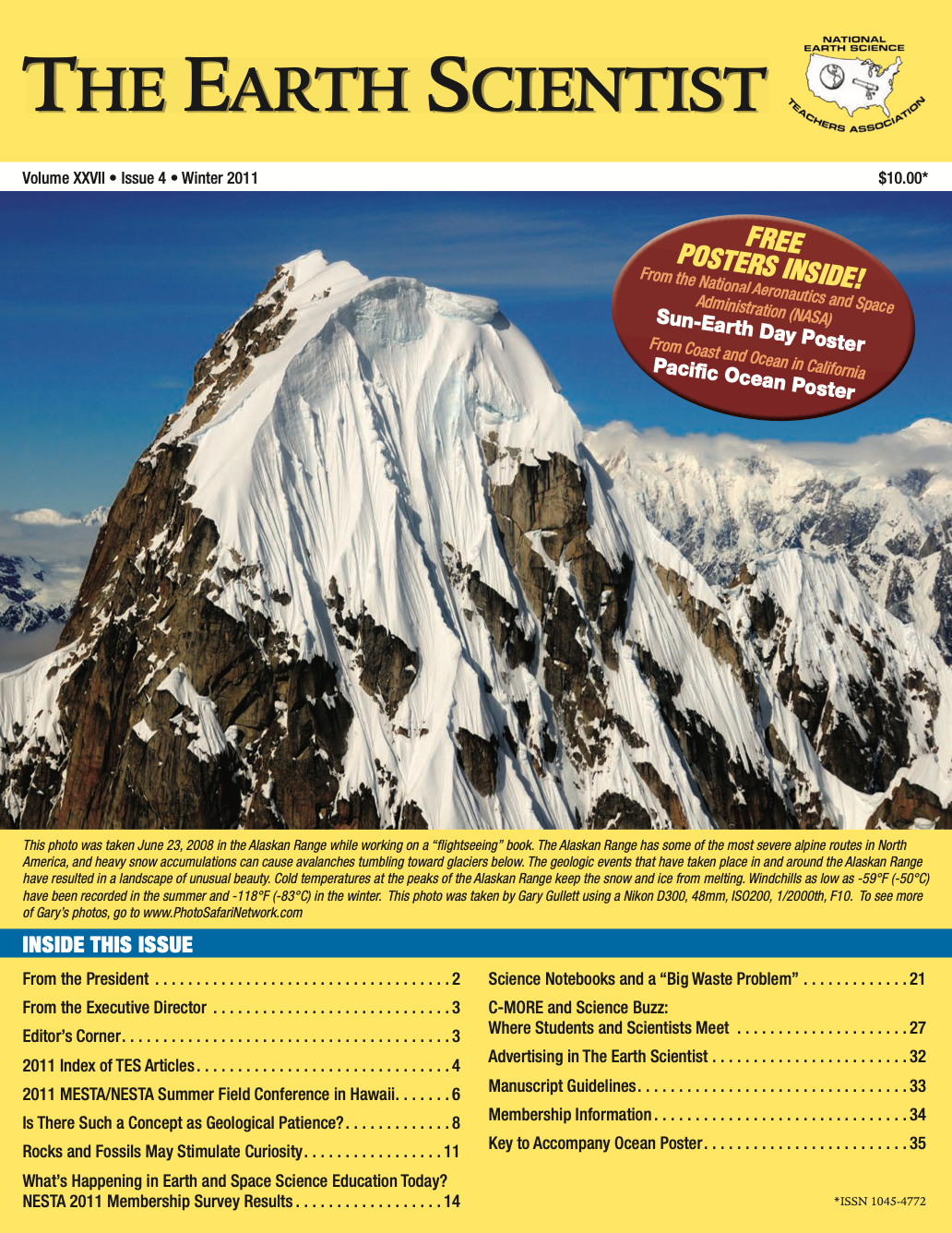 |
Winter 2011
- 2011 MESTA/NESTA Summer Field Conference in Hawaii by Aurelian Balan
- Is There Such a Concept as Geological Patience? by John Trowbridge
- Rocks and Fossils May Stimulate Curiosity by Xin Wang and Jeffrey Jay
- What's Happening in Earth and Space Science Education Today? NESTA 2011 Membership Survey Results by Roberta Johnson
- Science Notebooks and a "Big Waste Problem"by Debbie Muthersbaugh, Anne L. Kern, Jerine Pegg, Hal W. Clark
- C-MORE and Science Buzz: Where Students and Scientists Meet by Barbara Mayer and Barbara Bruno
|
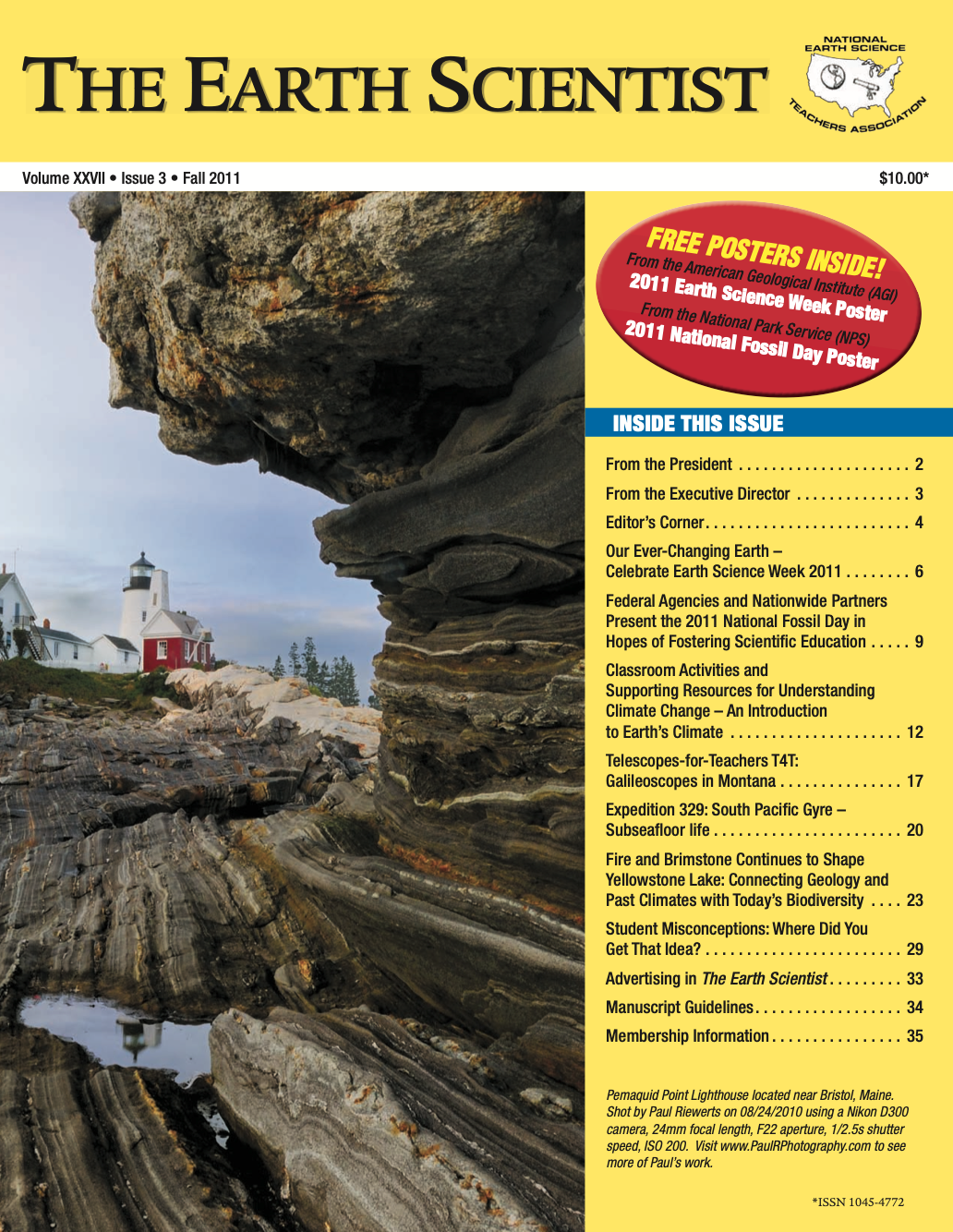 |
Fall 2011
- Our Ever-Changing Earth – Celebrate Earth Science Week 2011 by Geoff Camphire
- Federal Agencies and Nationwide Partners Present the 2011 National Fossil Day in Hopes of Fostering Scientific Education by Jason Kenworthy and Eva Lyon
- Classroom Activities and Supporting Resources for Understanding Climate Change – An Introduction to Earth’s Climate by Roberta Johnson, Sandra Henderson, Dennis Ward, Lisa Gardiner and Randy Russell
- Telescopes-for-Teachers T4T: Galileoscopes in Montana by Richard Jones
- Expedition 329: South Pacific Gyre – Subseafloor life by Joe Monaco
- Fire and Brimstone Continues to Shape Yellowstone Lake: Connecting Geology and Past Climates with Today’s Biodiversity by Susan Kelly, Lisa Morgan and Stephanie McGinnis
- Student Misconceptions: Where Did You Get That Idea? by Virginia Malone
|
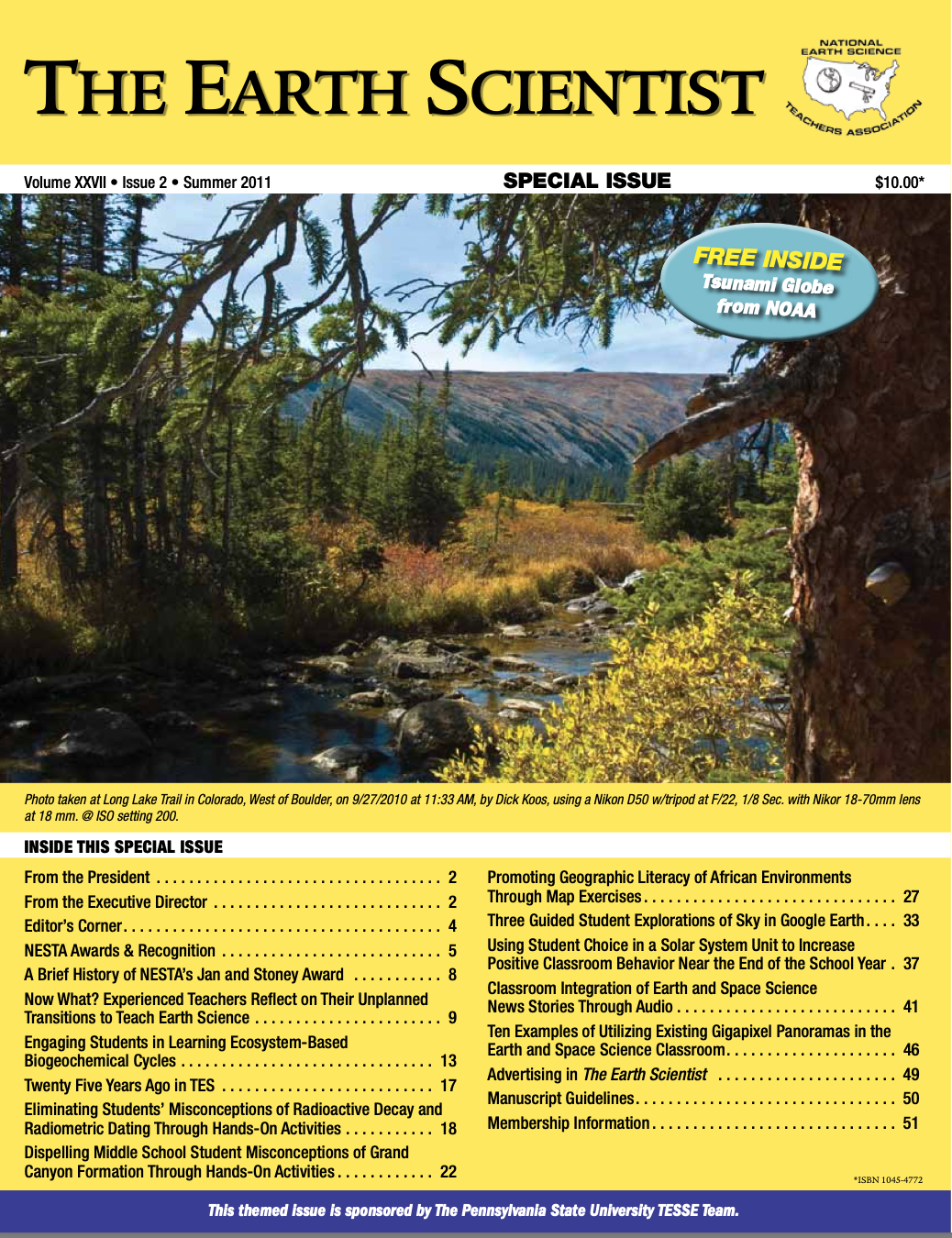 |
Summer 2011
- Now What? Experienced Teachers Reflect on Their Unplanned Transitions to Teach Earth Science by Tanya Furman, Laura Guertin and Megan Pickard
- Engaging Students in Learning Ecosystem-Based Biogeochemical Cycles by Holly Cole,Tanya Furman, Laura Guertin and Chira Endress Cratsley
- Eliminating Students' Misconceptions of Radioactive Decay and Radiometric Dating Through Hands-On Activities by Brenda Shafer, Chira Endress Cratsley and Tanya Furman
- Dispelling Middle School Student Misconceptions of Grand Canyon Formation Through Hands-On Activities by Kathleen Tait, Megan Pickard, Laura Guertin and Tanya Furman
- Promoting Geographic Literacy of African Environments Through Map Exercises by Chira Endress Cratsley, Laura Guertin and Tanya Furman
- Three Guided Student Explorations of Sky in Google Earth by Sara Neville and Laura Guertin
- Using Student Choice in a Solar System Unit to Increase Positive Classroom Behavior Near the End of the School Year by Sarah JM Gajeski, Nancy Miller and Megan Pickard
- Classroom Integration of Earth and Space Science News Stories Through Audio by Laura Guertin
- Ten Examples of Utilizing Existing Gigapixel Panoramas in the Earth and Space Science Classroom by Sara Neville and Laura Guertin
|
 |
 Spring 2011 Spring 2011
- Episodic Tremor and Slip: Potential Clues to the Earthquake Process and How Faults Slip by Michael R. Brudzinski
- Episodic Tremor and Slip in a Middle School Classroom?Absolutely! Relevance and Kinesthetic Methodologies MeritInclusion in 8th Grade Earth/Space Science Class by Roger Groom, Shelley Olds, Robert F. Butler and JendaJohnson
- USArray Visualizations Show Seismic Waves SweepingAcross the U.S. by Robert F. Butler, Christopher D.Hedeen and Roger Groom
- Understanding Earth Processes: Student AlternativeConceptions about Geophysics Concepts by Julie Libarkin and Emily Geraghty Ward
- A Big Squeeze: Examining and Modeling Causes ofIntraplate Earthquakes in the Earth Science Classroom,by Michael Hubenthal, Seth Stein and John Taber
|
| |
 |
Winter 2010
- The Crater Beneath the Corn Fields: Iowa’s Manson Impact Structure by Raymond R. Anderson and Brian J. Witzke
- Galileoscopes Across the USA by Ardis Herrold
- ISTEP: An International High School Student and Teacher Research Collaboration by By Sau Ling (Charlene) Chan, Brendan Buckley, Glen R. Kowach, and Michael J. Passow
- Yes Sir, That’s My Baby…Glacier! Making Glaciers Real and Personal by Christopher Roemmele
- Teaching with Screen-Capture Podcasts by Wendy Van Nordenl
- An Overview of Pyro-Cumulonimbus Thunderstorms by R. James Vavrek
|
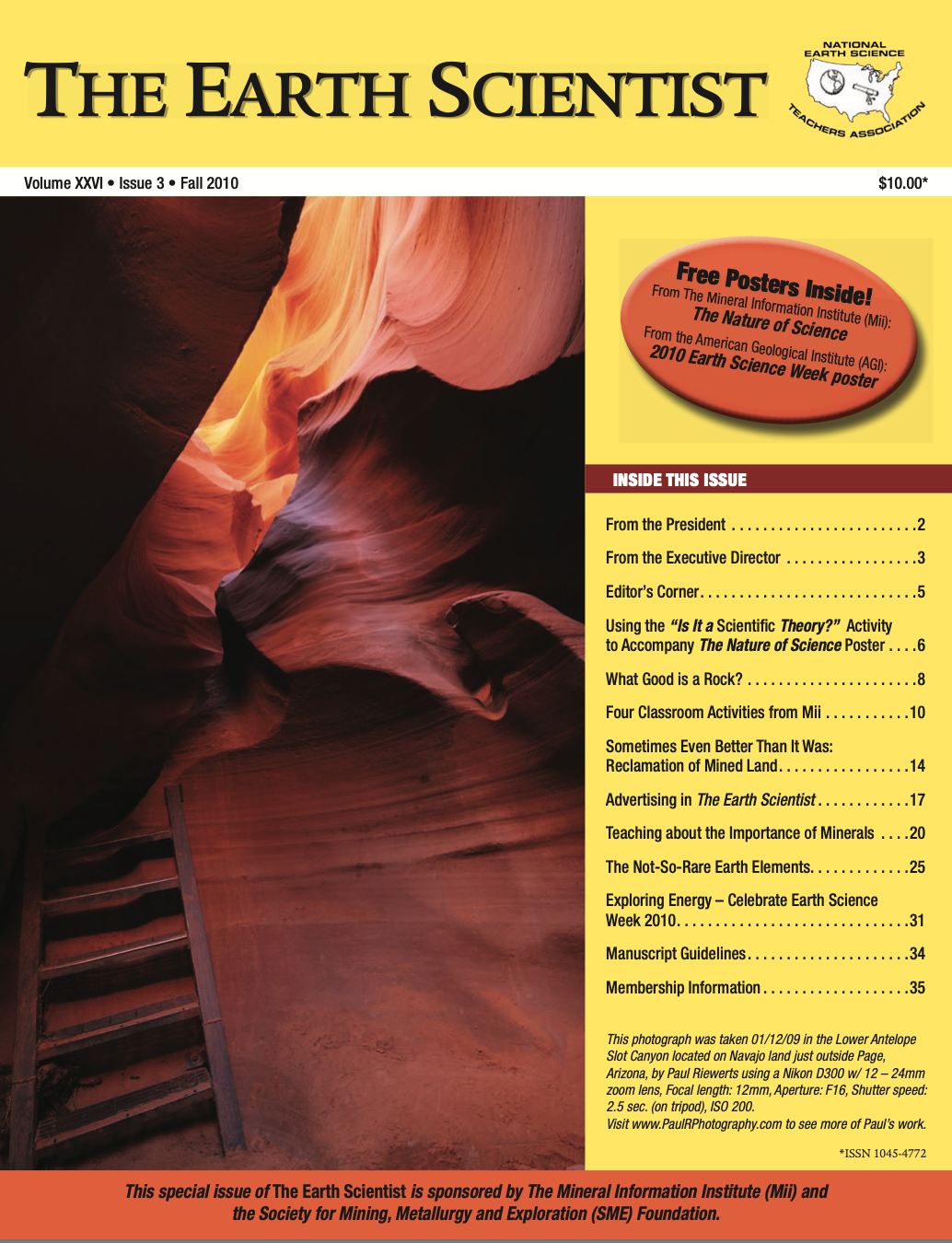 |
Fall 2010
- Using the "Is It a Scientific Theory?" Activity to Accompany The Nature of Science Poster
adapted by John W. Christensen, Global Science Curriculum Project
- What Good is a Rock?, by Pat Oso, Mineral Information Institute
- Sometimes Even Better Than It Was: Reclamation of Mined Land, by Andrew A. Sicree, Ph.D., Grace Prep High School
- Teaching about the Importance of Minerals, by John W. Christensen, Global Science Curriculum Project
- The Not-So-Rare Earth Elements, by Andrew A. Sicree, Ph.D., Grace Prep High School
- Exploring Energy - Celebrate Earth Science Week 2010, by Geoff Camphire, American Geological Institute
|
 |
Summer 2010
- River Enhanced Snow Bands on the Mississippi River, by Andy Ervin
- Low Budget Planetarium: A Classroom Model of the Night Sky, by Missy Holzer
- A Primer on Satellite Oceanography, by Dr. Michael Passow
- Using the Sciences of Geology and Archaeology to Bring Inquiry into the Classroom, by Shelly Anne Witham
- GEMS Space Science Sequence: Making the Intangible Aspects of Astronomy Hands-on Using an Inquiry Approach, by Dr. James T. McDonald
- As Evidence Grows, Will the Climate Debate Slow?, by Teri Eastburn
|
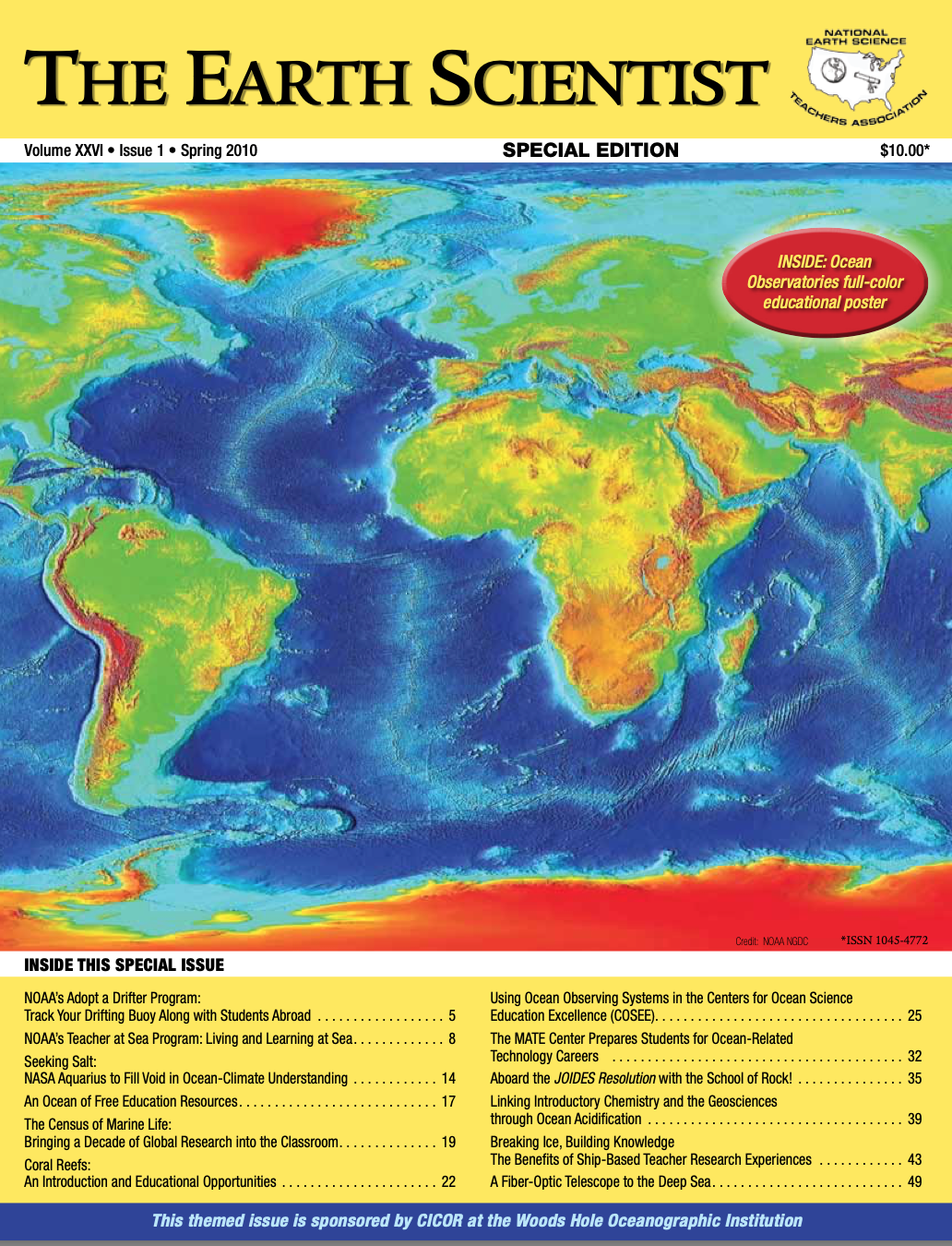 |
 Spring 2010 Spring 2010
- NOAA's Adopt a Drifter Program: Track Your Drifting Buoy Along with Students Abroad by Diane M. Stanitski, NOAA Climate Program Office, Climate Observation Division
- NOAA's Teacher at Sea Program: Living and Learning at Sea by Elizabeth McMahon and Jennifer Hammond, NOAA's Teacher at Sea Program
- Seeking Salt: NASA Aquarius to Fill Void in Ocean-Climate Understanding by Annette deCharon, University of Maine School of Marine Sciences
- The Bridge: An Ocean of Free Education Resources by Christopher Petrone, Virginia Sea Grant Marine Extension Program
- The Census of Marine Life: Bringing a Decade of Global Research into the Classroom by Celia Cackowski, Office of Marine Programs, University of Rhode Island
- Coral Reefs: An Introduction and Educational Opportunities by Paulo Maurin, NOAA Coral Reef Conservation Program
- Using Ocean Observing Systems in the Centers for Ocean Science Education Excellence (COSEE) by Janice McDonnel (Rutgers University), Annette deCharon (University of Maine), and Cheryl Peach (Scripps Institute of Oceanography)
- The MATE Center Prepares Students for Ocean-Related Technology Careers by Jill Zande and Caroline Brown, Marine Advanced Technology Center, Monterey Peninsula College
- Aboard the JOIDES Resolution with the School of Rock!, by Joe Monaco, Redlands East Valley High School
- Linking Introductory Chemistry and the Geosciences through Ocean Acidification
by Sarah Cooley and Heather Benway, Woods Hole Oceanographic Institution
- Breaking Ice, Building Knowledge: The Benefits of Ship-Based Teacher Research Experiences by Dolores Garay (Redd School), Janet Warburton (Polar TREC), and Kristin Timm (Arctic Research Consortium of the US)
- A Fiber-Optic Telescope to the Deep Sea by Nancy Penrose, Regional Scale Nodes Program, University of Washington
|
|